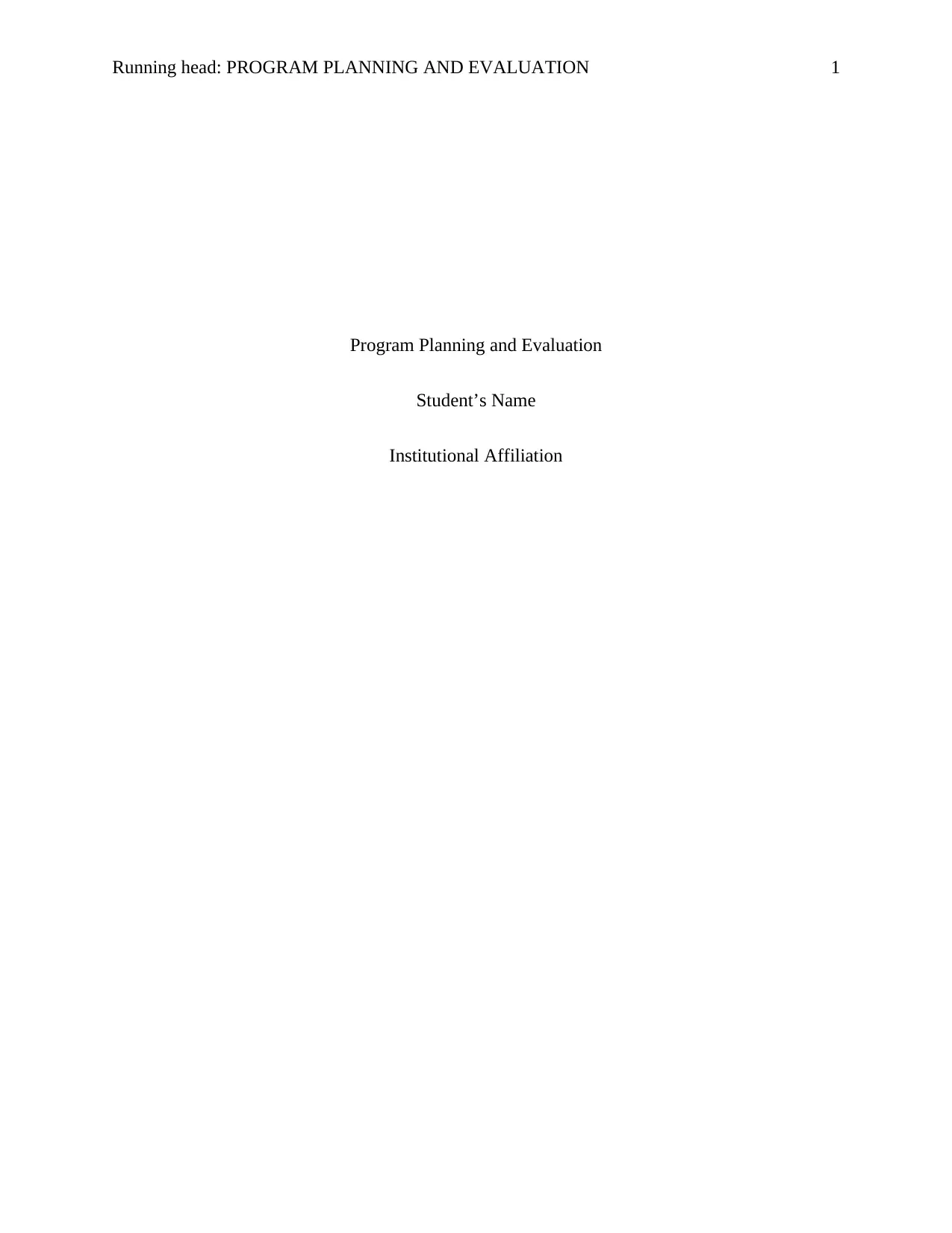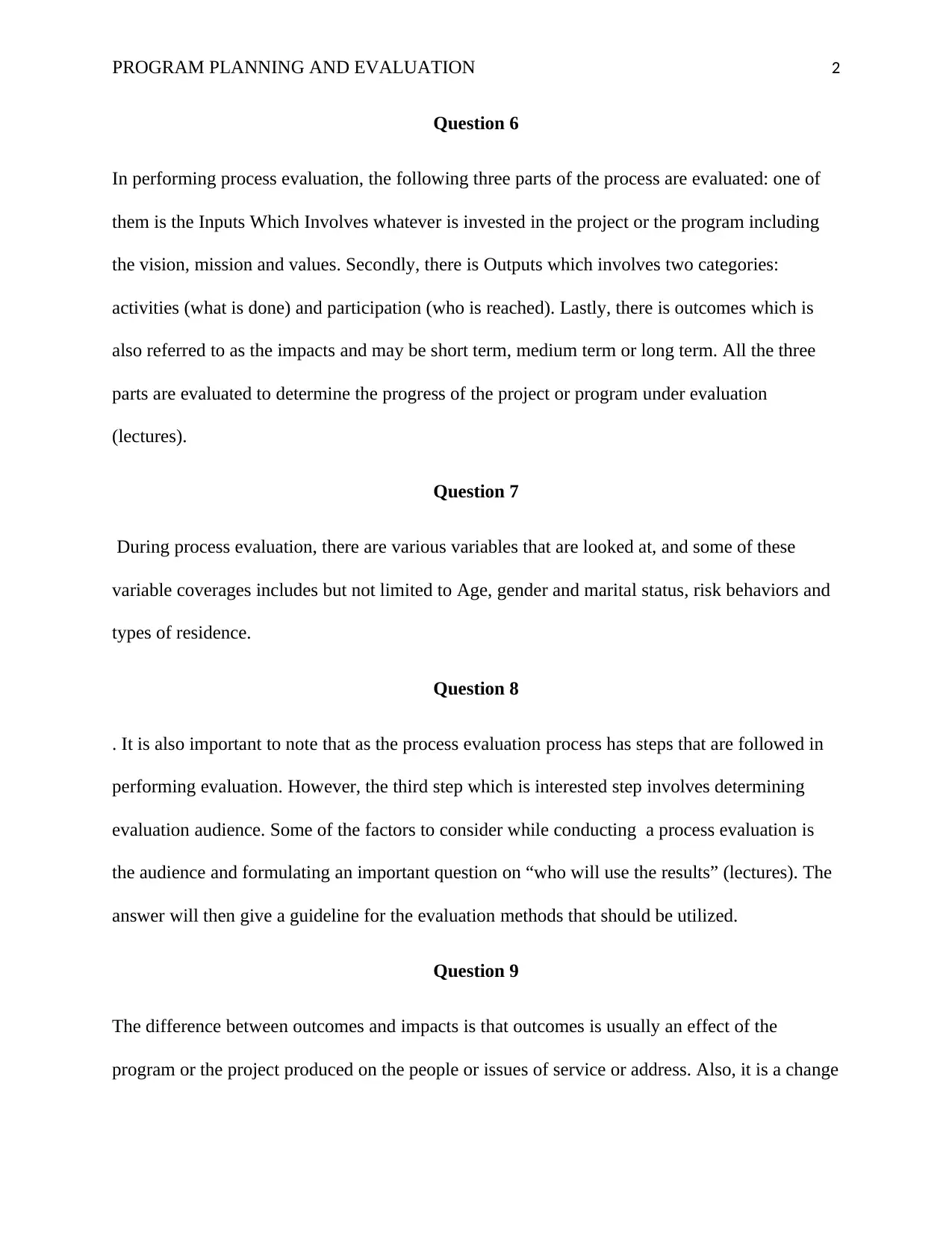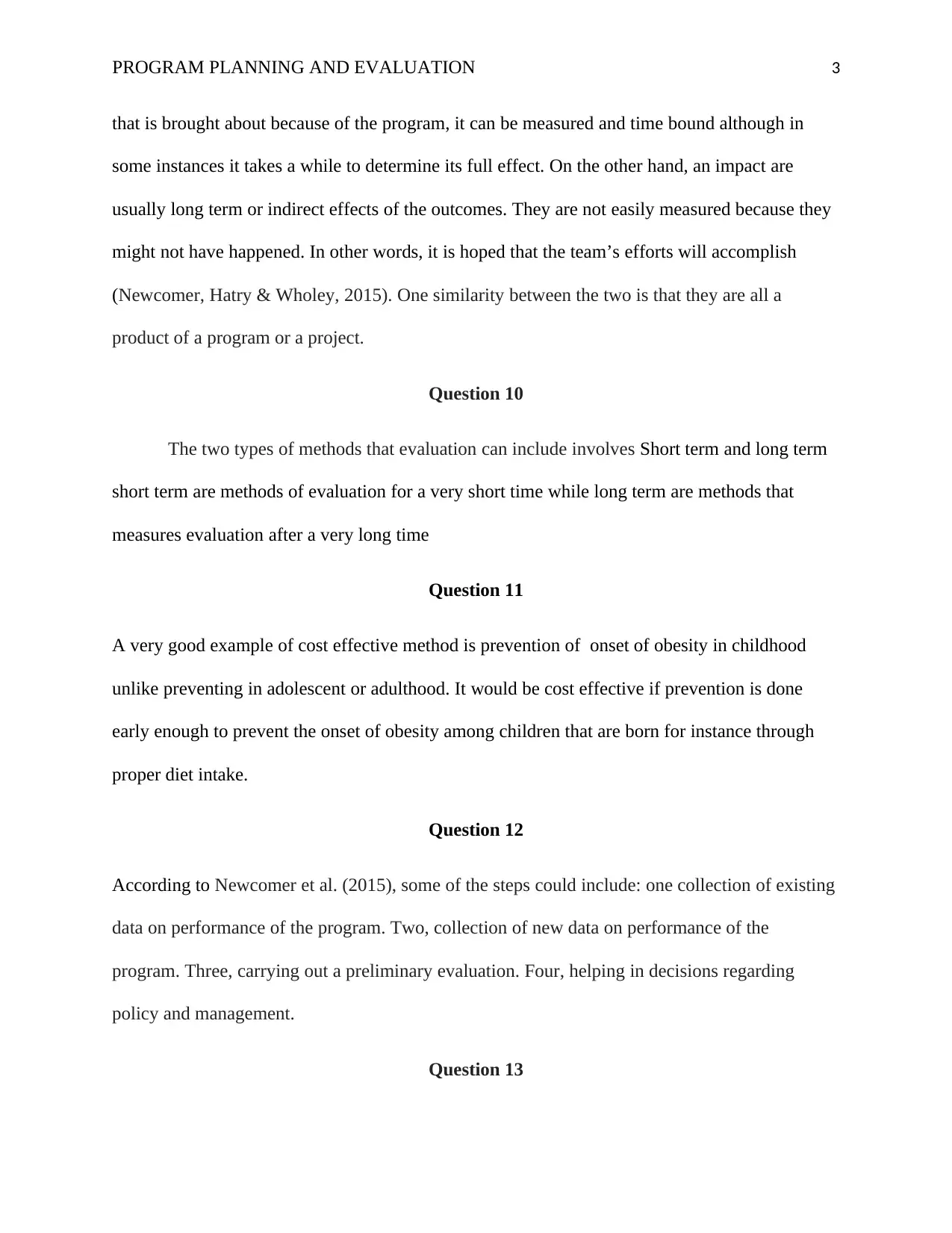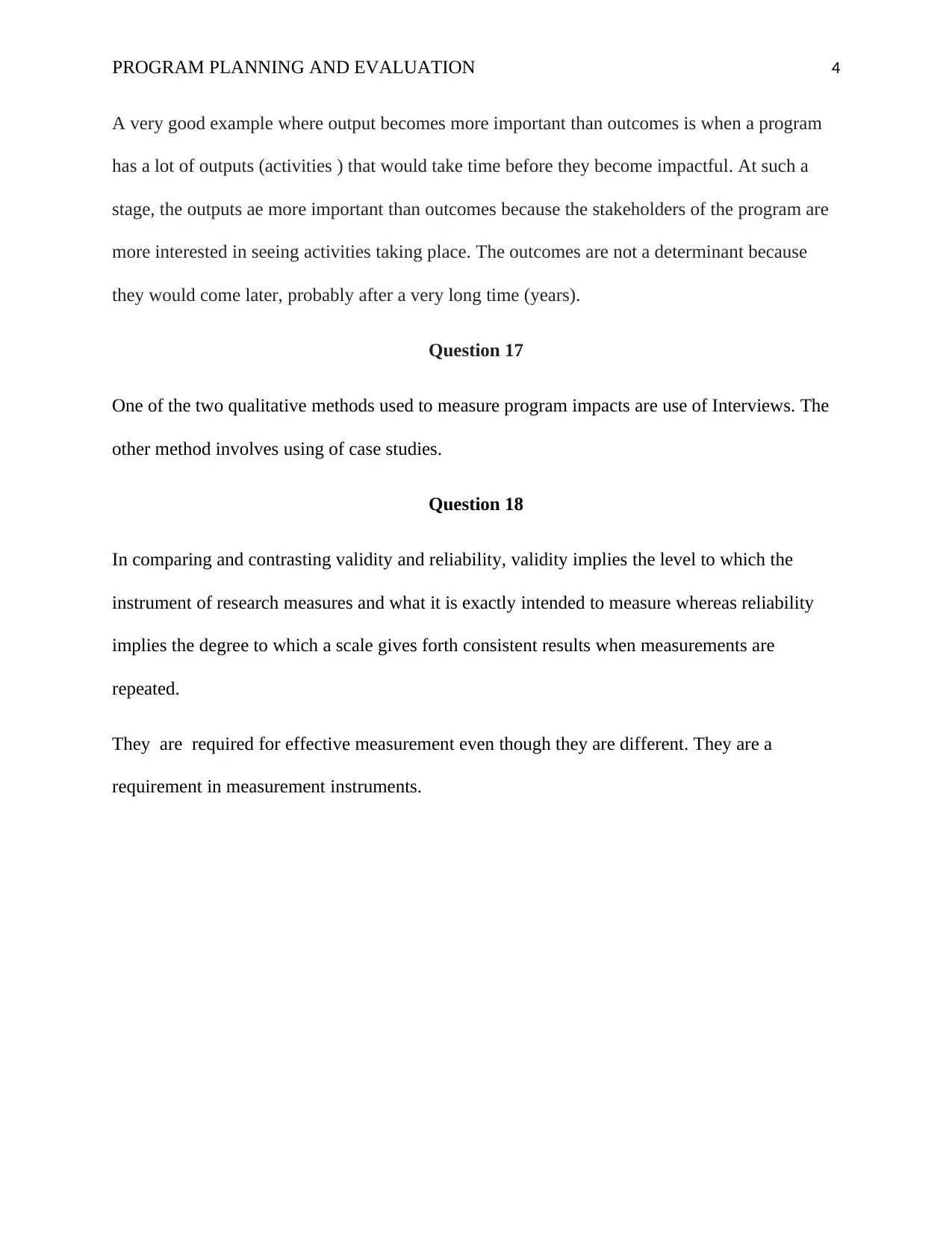HB 643Q Module 2-5: Program Planning and Evaluation
VerifiedAdded on 2022/10/06
|5
|772
|17
Homework Assignment
AI Summary
This assignment focuses on program planning and evaluation, drawing on lectures from HB 643Q. It delves into the key components of program evaluation, including process, outcomes, and impact assessments. The solution addresses questions on process evaluation variables, the importance of audience in evaluation, the differences between outcomes and impacts, and different evaluation methods. It also includes examples of cost-effective measures, rapid feedback evaluation, and situations where outputs are more important than outcomes. Qualitative methods for measuring program impacts and the comparison of validity and reliability are also discussed. The assignment provides a comprehensive overview of program evaluation concepts, methodologies, and practical applications.

Running head: PROGRAM PLANNING AND EVALUATION 1
Program Planning and Evaluation
Student’s Name
Institutional Affiliation
Program Planning and Evaluation
Student’s Name
Institutional Affiliation
Paraphrase This Document
Need a fresh take? Get an instant paraphrase of this document with our AI Paraphraser

PROGRAM PLANNING AND EVALUATION 2
Question 6
In performing process evaluation, the following three parts of the process are evaluated: one of
them is the Inputs Which Involves whatever is invested in the project or the program including
the vision, mission and values. Secondly, there is Outputs which involves two categories:
activities (what is done) and participation (who is reached). Lastly, there is outcomes which is
also referred to as the impacts and may be short term, medium term or long term. All the three
parts are evaluated to determine the progress of the project or program under evaluation
(lectures).
Question 7
During process evaluation, there are various variables that are looked at, and some of these
variable coverages includes but not limited to Age, gender and marital status, risk behaviors and
types of residence.
Question 8
. It is also important to note that as the process evaluation process has steps that are followed in
performing evaluation. However, the third step which is interested step involves determining
evaluation audience. Some of the factors to consider while conducting a process evaluation is
the audience and formulating an important question on “who will use the results” (lectures). The
answer will then give a guideline for the evaluation methods that should be utilized.
Question 9
The difference between outcomes and impacts is that outcomes is usually an effect of the
program or the project produced on the people or issues of service or address. Also, it is a change
Question 6
In performing process evaluation, the following three parts of the process are evaluated: one of
them is the Inputs Which Involves whatever is invested in the project or the program including
the vision, mission and values. Secondly, there is Outputs which involves two categories:
activities (what is done) and participation (who is reached). Lastly, there is outcomes which is
also referred to as the impacts and may be short term, medium term or long term. All the three
parts are evaluated to determine the progress of the project or program under evaluation
(lectures).
Question 7
During process evaluation, there are various variables that are looked at, and some of these
variable coverages includes but not limited to Age, gender and marital status, risk behaviors and
types of residence.
Question 8
. It is also important to note that as the process evaluation process has steps that are followed in
performing evaluation. However, the third step which is interested step involves determining
evaluation audience. Some of the factors to consider while conducting a process evaluation is
the audience and formulating an important question on “who will use the results” (lectures). The
answer will then give a guideline for the evaluation methods that should be utilized.
Question 9
The difference between outcomes and impacts is that outcomes is usually an effect of the
program or the project produced on the people or issues of service or address. Also, it is a change

PROGRAM PLANNING AND EVALUATION 3
that is brought about because of the program, it can be measured and time bound although in
some instances it takes a while to determine its full effect. On the other hand, an impact are
usually long term or indirect effects of the outcomes. They are not easily measured because they
might not have happened. In other words, it is hoped that the team’s efforts will accomplish
(Newcomer, Hatry & Wholey, 2015). One similarity between the two is that they are all a
product of a program or a project.
Question 10
The two types of methods that evaluation can include involves Short term and long term
short term are methods of evaluation for a very short time while long term are methods that
measures evaluation after a very long time
Question 11
A very good example of cost effective method is prevention of onset of obesity in childhood
unlike preventing in adolescent or adulthood. It would be cost effective if prevention is done
early enough to prevent the onset of obesity among children that are born for instance through
proper diet intake.
Question 12
According to Newcomer et al. (2015), some of the steps could include: one collection of existing
data on performance of the program. Two, collection of new data on performance of the
program. Three, carrying out a preliminary evaluation. Four, helping in decisions regarding
policy and management.
Question 13
that is brought about because of the program, it can be measured and time bound although in
some instances it takes a while to determine its full effect. On the other hand, an impact are
usually long term or indirect effects of the outcomes. They are not easily measured because they
might not have happened. In other words, it is hoped that the team’s efforts will accomplish
(Newcomer, Hatry & Wholey, 2015). One similarity between the two is that they are all a
product of a program or a project.
Question 10
The two types of methods that evaluation can include involves Short term and long term
short term are methods of evaluation for a very short time while long term are methods that
measures evaluation after a very long time
Question 11
A very good example of cost effective method is prevention of onset of obesity in childhood
unlike preventing in adolescent or adulthood. It would be cost effective if prevention is done
early enough to prevent the onset of obesity among children that are born for instance through
proper diet intake.
Question 12
According to Newcomer et al. (2015), some of the steps could include: one collection of existing
data on performance of the program. Two, collection of new data on performance of the
program. Three, carrying out a preliminary evaluation. Four, helping in decisions regarding
policy and management.
Question 13
⊘ This is a preview!⊘
Do you want full access?
Subscribe today to unlock all pages.

Trusted by 1+ million students worldwide

PROGRAM PLANNING AND EVALUATION 4
A very good example where output becomes more important than outcomes is when a program
has a lot of outputs (activities ) that would take time before they become impactful. At such a
stage, the outputs ae more important than outcomes because the stakeholders of the program are
more interested in seeing activities taking place. The outcomes are not a determinant because
they would come later, probably after a very long time (years).
Question 17
One of the two qualitative methods used to measure program impacts are use of Interviews. The
other method involves using of case studies.
Question 18
In comparing and contrasting validity and reliability, validity implies the level to which the
instrument of research measures and what it is exactly intended to measure whereas reliability
implies the degree to which a scale gives forth consistent results when measurements are
repeated.
They are required for effective measurement even though they are different. They are a
requirement in measurement instruments.
A very good example where output becomes more important than outcomes is when a program
has a lot of outputs (activities ) that would take time before they become impactful. At such a
stage, the outputs ae more important than outcomes because the stakeholders of the program are
more interested in seeing activities taking place. The outcomes are not a determinant because
they would come later, probably after a very long time (years).
Question 17
One of the two qualitative methods used to measure program impacts are use of Interviews. The
other method involves using of case studies.
Question 18
In comparing and contrasting validity and reliability, validity implies the level to which the
instrument of research measures and what it is exactly intended to measure whereas reliability
implies the degree to which a scale gives forth consistent results when measurements are
repeated.
They are required for effective measurement even though they are different. They are a
requirement in measurement instruments.
Paraphrase This Document
Need a fresh take? Get an instant paraphrase of this document with our AI Paraphraser

PROGRAM PLANNING AND EVALUATION 5
References
Newcomer, K. E., Hatry, H. P., & Wholey, J. S. (Eds.). (2015). Handbook of practical program
evaluation. USA: John Wiley & Sons.
References
Newcomer, K. E., Hatry, H. P., & Wholey, J. S. (Eds.). (2015). Handbook of practical program
evaluation. USA: John Wiley & Sons.
1 out of 5
Related Documents
Your All-in-One AI-Powered Toolkit for Academic Success.
+13062052269
info@desklib.com
Available 24*7 on WhatsApp / Email
![[object Object]](/_next/static/media/star-bottom.7253800d.svg)
Unlock your academic potential
Copyright © 2020–2025 A2Z Services. All Rights Reserved. Developed and managed by ZUCOL.





